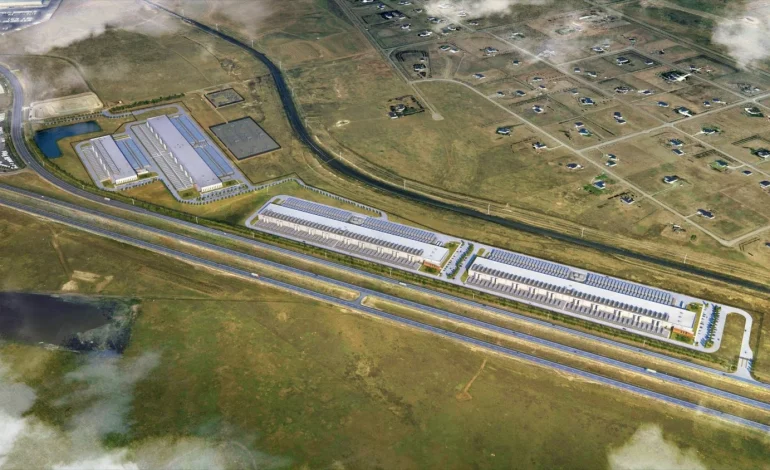The original story by for
Cheyenne is getting another giant stack of computers. With Microsoft and Meta already planted on the high plains, RelatedDigital just broke ground on a $1.2 billion data center on the city’s east side, a project local leaders say should be up and humming by late 2026. The mayor and Gov. Mark Gordon grabbed shovels alongside RelatedDigital’s CEO to mark the start. CoreWeave — the fast-growing AI and cloud outfit — has signed on as the anchor customer.
Big builds like this bring big questions in Wyoming: how much water they’ll use, what the power bill looks like, and whether dozens of diesel generators will foul the air. Colin Sullivan, a senior vice president at RelatedDigital, says the company came to Cheyenne with those worries in mind and designed the campus around them.
On water, the promise is eye-catching. Instead of open-loop evaporative cooling that can swallow millions of gallons a year, the Cheyenne site will run high-efficiency, air-cooled chillers on a closed loop. In plain English, think radiators and fans rather than evaporating water into thin air. Sullivan calls the daily draw “nominal,” pegging most of it to restrooms, pantries, sinks and a bit of humidity control. With staffing for the first building running about the size of a forty-person office, he says the center’s day-to-day consumption works out to roughly “six bathrooms’ worth of water.” In a state where every drop is argued over, that line landed by design.
Of course, if you don’t evaporate water to carry away heat, fans and compressors have to work harder. Sullivan concedes the tradeoff: air-cooled systems can burn a little more electricity. He argues the technology isn’t experimental — it’s standard in the industry now — and the overall equation still favors Cheyenne because it preserves a scarce resource while pumping more taxable power demand into the grid.
Power is the second pillar of the plan. RelatedDigital isn’t building its own plant; it will buy from the grid, with Black Hills Energy as the utility. The first phase is sized to deliver 88 megawatts to CoreWeave, with a roadmap to scale that to roughly 302 megawatts as additional halls open. That’s a small town’s worth of load focused on a few square blocks. Sullivan points to a large-power tariff Black Hills created for industrial users, saying it lets the utility serve big data loads “with no cost impact to local retail customers.” In other words, the company’s bet is that growth pays for growth, not the residential ratepayer — something folks will be able to test when the meter starts spinning.
The third concern is the stack of generators. An air permit covering fifty-one diesel backup engines sounds ominous, and residents wanted to know whether those would quietly double as peaker plants during high-price hours. Sullivan pushes back on that idea. The engines are “purely for backup,” he says, sitting idle unless the grid fails. He adds that the company has worked through the air rules with the Department of Environmental Quality to ensure compliance, from testing schedules to emissions controls. Most days, he says, all power flows from Black Hills.
Jobs are another flashpoint in the data-center debate. During construction, RelatedDigital expects to put about seven hundred people to work. Once the doors open, the operation shrinks to a tight crew — around forty full-time positions — because the buildings are designed to be clean, secure and highly automated. Sullivan stresses that the small headcount doesn’t mean low quality: most roles are well-paid technical and engineering jobs, plus a handful of administrative and facilities positions. The idea, he says, isn’t to skimp on labor but to run the plant safely and efficiently.
Wyoming didn’t have to throw a kitchen sink of incentives at the deal. Sullivan says the only benefit they’re using is the state’s long-standing sales-tax exemption on data-center equipment, a policy on the books since about 2012 and common across more than thirty states. In places that don’t offer it, he notes, far fewer data centers have been built. For Cheyenne, the calculus is straightforward: forgo sales tax on racks and servers in exchange for a durable property-tax base and years of electricity, construction and supplier spending.
So what’s in it for locals beyond tax receipts? Sullivan argues the upside arrives in two flavors. One is the obvious revenue stream to city, county and state budgets. The other is less tangible but still felt: corporate projects tied to community needs. He points to things like road upgrades in the Cheyenne Business Parkway, work on the Greenway, and donations for affordable housing. RelatedDigital has already zeroed in on that last piece, saying it heard loud and clear about the shortage of attainable homes in the capital and intends to help. The company’s case is that when a data center shows up, it doesn’t just process data; it underwrites parks, paths and housing that might otherwise sit on a wish list.
As for what a data center actually “makes,” Sullivan is frank: it doesn’t spit out widgets with “Made in Wyoming” stamped on them. It’s racks of computers storing and processing the stuff that runs everything else — AI training jobs, streaming, logistics, banking, telemedicine. The benefit to Cheyenne is indirect but real, he says: better connectivity for businesses and residents, faster access to information and services, and a foothold in an industry that’s now basic infrastructure, like highways and power lines. With CoreWeave as the first tenant, the pitch is that Cheyenne is not just hosting someone else’s internet—it’s part of the engine room for modern computing.
None of this answers every question. The grid has to keep up. Backup engines need to stay truly “in case of emergency.” Air-cooled systems have to deliver on the low-water promise without creating new headaches. And forty full-time jobs won’t transform the labor market overnight. But the outlines are clear: a late-2026 opening, heavy up-front construction work, a lean operations team, a closed-loop cooling design aimed at conserving water, and a long bet on data as a base industry for the capital city.
Cheyenne has been here before. Microsoft and Meta proved the market. Now RelatedDigital is testing whether a drier, more power-hungry cooling approach can win over a community that keeps a close eye on its aquifers. If the company hits its marks — sipping water, paying its bills, and showing up for local priorities — it’ll have a decent shot at making “server farm” sound a little more like “good neighbor.”










The latest news in your social feeds
Subscribe to our social media platforms to stay tuned